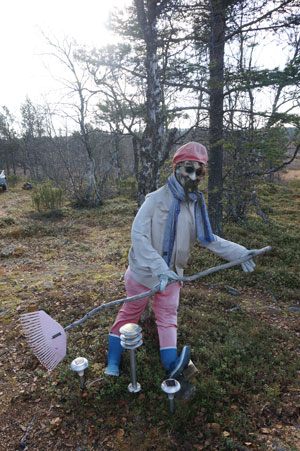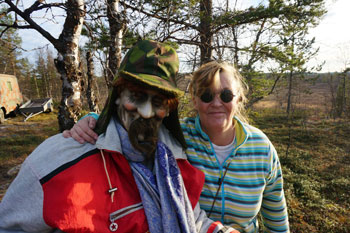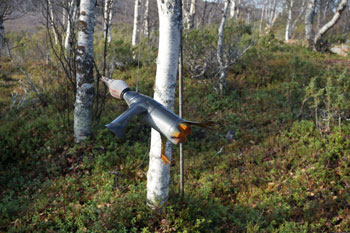NPE team’s researchers Terhi Vuojala-Magga and Joonas Vola have spent this autumn conducting their fieldwork for the international RESCuE project in different locations around Lapland. During the fieldwork in Inari by the sand road to Kuttura they encountered also something unexpected:, the old gold digger’s figure, the gold-chap.
 It is footed on water resisting rubber boots, where the rest of its wooden core is covered with textile clothing and the grinning plastic-rubber face’s eyes are protected from the brightness of the midnight sun with round sunglasses. It is already autumn, so the gold-chap has been given a rake; the gardener of the wilderness, housekeeper under the open sky and guardian of the gold to be found.
It is footed on water resisting rubber boots, where the rest of its wooden core is covered with textile clothing and the grinning plastic-rubber face’s eyes are protected from the brightness of the midnight sun with round sunglasses. It is already autumn, so the gold-chap has been given a rake; the gardener of the wilderness, housekeeper under the open sky and guardian of the gold to be found.
The very first sight of the gold-chap easily raises uncanny feelings. Its figure clearly stands out from the surrounding landscape, and even more so when it gets dark and its figure is brought out by the light spots beneath its twisted legs. For an outsider, the sensory-emotional value, the aesthetics of this creation or creature, seems easily detached from the environment and the gold panners’ life. It does not follow the form of the sculptures of Polykleitos, it is not decorated with gold as a sign of prosperity gathered from the area, nor is it trying to expel and scare the ones approaching the place where it stands. Instead of judgments of sentiment and taste, the gold-chap needs to be seen more broadly as a reflection of economy, ecology and entertainment and how these elements visually manifest themselves in the borderline of culture and nature.
Having a look under the clothing reveals that the arms, legs, neck and back are actually a single piece of wood, so that the limbs are not made by cutting, bending or carving. The hidden core of the gold-chap is completely made with solar energy under the Northern sky. As the latest developed car engines, gold-chap is also a hybrid consisting of various recycled materials from cotton to wool, rubber, nylon and plastic. Not even one piece of the gold-chap is especially manufactured or produced for it; it has been simply put together. Rather than being an abandoned ghastly figure, it signifies the presence of those who have lived in and visited that spot and brought their own clothing and accessories to mark the livelihood that is maintained in these lands. It also emphasizes a sense of humor and entertainment. This spirited guardian is the true genius loci of the gold claim and the gold panners’ camp.
The gold-chap does not only reveal different aesthetics perspectives but he can be seen as a transformation of a wooden creature to a kind of spiritual human figure as the seasons change. While the people of the Caramba enjoy their summers in panning gold, the good old wooden fellow keeps on looking at the men and their friends. Gold panners work, sit beside the fire, tell stories, play music and sing. During the summer time the wooden figure is hardly seen from the road nor can he see to the road, he is hidden behind the green leaves of birch trees. During the summer, his role is to share the happiness and freedom of wilderness with his southern mates.
However, once the winter comes the gold diggers disappear back to south and the song of birds and men is finished. In the quietness of the vast land of snow and darkness, the only tracks beside the empty road are from wild life of predators and prays. The old fellow becomes a lone creature: on the one hand, he represents the lost happiness of the past summer. And yet, on the other hand, his appearance is stronger than ever before, because now he stands on open ground of bare trees – he can see the empty road. Each time Terhi drives by the man he becomes to be more and more visible, not only as a piece of art but as a living creature of humanity. He faces a transformation from a wooden creature to the only human being of wilderness.
In this transformation the winter and cold makes the man freeze. His summer clothes do not keep him warm. Eventually Terhi negotiated with the men of Caramba that she is allowed to dress the old chap with warmer clothes once the weather gets colder. When the man has been dressed up with warm clothes and Terhi passes him, she feels like the man is waving his hand: “It´s fine now, I will keep on watching you while you drive this road. Thanks!”
The Aesthetic discussion of objects and things being tacky or tasteful is out of question in this lived reality. The combination of different elements is not reflecting collage style but speaking out the appreciation and necessity of re-use and circulation of rare materials and goods. The evaluation of ‘the nature of art’ has the pressure on the word ‘art’ as a skill, art of skilled people to make the best out of their environment: shared, comfortable and sustainable ways. Here the beauty is the visual manifestation of the art of sparse living. Whenever one faces a piece of art in a vast land in a long run, day after a day – the aesthetics start to get transformed to the spiritual levels perception and one enters to the Arctic world of magic.


Text and photos: Terhi Vuojala-Magga and Joonas Vola